The History of Surfing From Captain Cook to the Present By Ben Marcus
|
| ||||||||||||||||||||||||||||||||
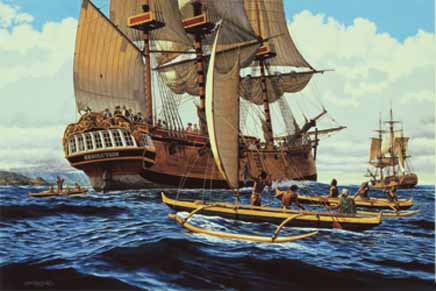 Lieutenant James King was made First Lieutenant of the Discovery and was given the task of completing the narrative portion of Cook's journals. After Cook's death in 1779 but before the Discovery and Resolution returned to England, Lt. King devoted two full pages to a description of surfboard riding, as practiced by the locals at Kealakekua Bay on the Kona coast of the Big Island. His following entry is the earliest written account of surfing. |
| ||||||||||||||||||||||||||||||||
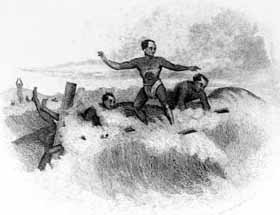 But a diversion the most common is upon the Water, where there is a very great Sea, and surf breaking on the Shore. The Men sometimes 20 or 30 go without the Swell of the Surf, & lay themselves flat upon an oval piece of plan about their Size and breadth, they keep their legs close on top of it, & their Arms are us'd to guide the plank, thye wait the time of the greatest Swell that sets on Shore, & altogether push forward with their Arms to keep on its top, it sends them in with a most astonishing Velocity, & the great art is to guide the plan so as always to keep it in a proper direction on the top of the Swell, & as it alters its direct. If the Swell drives him close to the rocks before he is overtaken by its break, he is much prais'd. On first seeing this very dangerous diversion I did not conceive it possible but that some of them must be dashed to mummy against the sharp rocks, but jus before they reach the shore, if they are very near, they quit their plank, & dive under till the Surf is broke, when the piece of plank is sent many yards by the force of the Surf from the beach. The greatest number are generally overtaken by the break of the swell, the force of which they avoid, diving and swimming under the water out of its impulse. By such like excercises, these men may be said to be almost amphibious. The Women could swim off to the Ship, & continue half a day in the Water, & afterwards return. The above diversion is only intended as an amusement, not a tryal of skill, & in a gentle swell that sets on must I conceive be very pleasant, at least they seem to feel a great pleasure in the motion which this Exercise gives.
But a diversion the most common is upon the Water, where there is a very great Sea, and surf breaking on the Shore. The Men sometimes 20 or 30 go without the Swell of the Surf, & lay themselves flat upon an oval piece of plan about their Size and breadth, they keep their legs close on top of it, & their Arms are us'd to guide the plank, thye wait the time of the greatest Swell that sets on Shore, & altogether push forward with their Arms to keep on its top, it sends them in with a most astonishing Velocity, & the great art is to guide the plan so as always to keep it in a proper direction on the top of the Swell, & as it alters its direct. If the Swell drives him close to the rocks before he is overtaken by its break, he is much prais'd. On first seeing this very dangerous diversion I did not conceive it possible but that some of them must be dashed to mummy against the sharp rocks, but jus before they reach the shore, if they are very near, they quit their plank, & dive under till the Surf is broke, when the piece of plank is sent many yards by the force of the Surf from the beach. The greatest number are generally overtaken by the break of the swell, the force of which they avoid, diving and swimming under the water out of its impulse. By such like excercises, these men may be said to be almost amphibious. The Women could swim off to the Ship, & continue half a day in the Water, & afterwards return. The above diversion is only intended as an amusement, not a tryal of skill, & in a gentle swell that sets on must I conceive be very pleasant, at least they seem to feel a great pleasure in the motion which this Exercise gives.
Thus, Lieutenant James King, commander of the Discovery, 1779, recorded in the ship's log the first written description of Hawaiian surfing by a European.
|
| ||||||||||||||||||||||||||||||||
|
| ||||||||||||||||||||||||||||||||
 Forced to migrate into the vast region by the push of population and the pull of the horizon, the first Polynesians arrived in the Hawaiian Islands in the fourth century A.D. The Polynesians who made the arduous journey from Tahiti and the Marquesas to Hawai'i were necessarily exceptional watermen and women who brought a deep love and knowledge of the ocean with them. The Polynesians who made it to Hawai'i also brought their customs with them, including playing in the surf on paipo (belly) boards. Although Tahitians are said to have occasionally stood on their boards, the art of surfing upright on long boards was certainly perfected if not invented in Hawai'i. |
| ||||||||||||||||||||||||||||||||
 When Captain Cook arrived in Hawai'i, surfing was deeply rooted in many centuries of Hawaiian legend and culture. Place names had been bestowed because of legendary surfing incidents. The kahuna (experts) intoned special chants to christen new surfboards, to bring the surf up and to give courage to the men and women who challenged the big waves. Hawaiians had no written language until the haole (white-skinned people) arrived, so their genealogy and history were remembered in songs and chants. There were legendary stories of love matches made and broken in the surf, lives risked and heroic ocean deeds by chiefs and commoners. |
| ||||||||||||||||||||||||||||||||
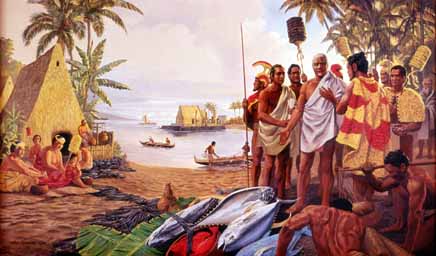 Before contact with Cook's crew, Hawai'i was ruled by a code of kapu (taboos) which regulated almost everything: where to eat; how to grow food; how to predict weather; how to build a canoe; how to build a surfboard; how to predict when the surf would be good, or convince the Gods to make it good. Hawaiian society was distinctly stratified into royal and common classes, and these taboos extended into the surf zone. There were reefs and beaches where the ali'i (chiefs) surfed and reefs and beaches where the commoners surfed. Commoners generally rode waves on paipo (prone) and alaia (stand up) boards as long as 12 feet, while the ali'i rode waves on olo boards that were as long as 24 feet. |
| ||||||||||||||||||||||||||||||||
 Several of Hawaii's most famous chiefs, including Kaumuali'i, the ruling chief of Kaua'i and Kamehameha I, were renowned for their surfing ability. Ali'i could prove their prowess by showing courage and skill in big waves, and woe betide the commoner who crossed into surf zones reserved for the ali'i. On the south shore of Oahu, at Waikiki, the surf spot now known as Outside Castles was called Kalehuaweke by the Hawaiians to commemorate an incident in which a commoner dropped into the same wave as a Hawaiian chiefess, which was a major taboo. To save his own skin, he offered her his lehua wreath to placate her. By the time Captain Cook and his ships reached the Hawaiian Islands in 1778, the art, sport and religion of surfing had reached a sophisticated peak. But what Cook and Lieutenant King described in Tahiti and Hawai'i was the zenith of the sport in Old Polynesia, because in the wake of the Resolution and the Discovery, Hawai'i and Hawaiian surfing fell into decline for more than 150 years. European contact was not good for Hawai'i. After the publication of Cook's and King's journals, Hawai'i became the central Pacific destination of choice for captains, brigands, adventurers, missionaries and other opportunists. The haole brought new technologies, languages and Gods, along with vices and diseases that ravaged a society that had evolved over more than a millennium. |
| ||||||||||||||||||||||||||||||||
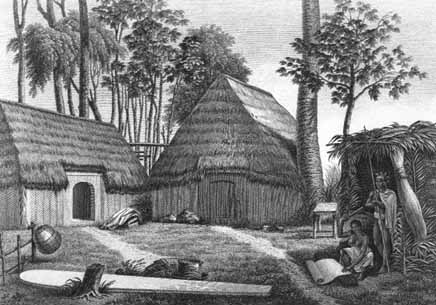 Haole and Hawaiian cultures were thrown together in swift collision at the end of the 18th century, and within the first 20 years of the 19th century, Hawai'i was changed forever. In 1819, less than 50 years after Cook made contact with the Hawaiians, Liholiho, the son and successor of Kamehameha I publicly sat down to eat with his mother and other high chiefesses. Men eating with women had been taboo since the beginning of time, but Liholiho had been swayed and overwhelmed by the overpowering influence of haole culture. His defiance of a cornerstone taboo sent a message throughout Hawai'i that the old system of laws was no longer to be followed, which dealt a fatal blow to the kapu system. As the kapu system crumbled, so did surfing's ritual significance within Hawaiian culture. Now a commoner could drop in on a chiefess without fear for his life, or even giving up his lehua wreath. The end of the kapu system also brought about the demise of the Makahiki festival, the annual celebration to the god Lono in which surfing played an integral role. But now that the Hawaiians had been set adrift from the old ways, Hawaiian culture fell into chaos. As James D. Houston and Ben Finney wrote in Surfing: A History of the Ancient Hawaiian Sport: "For surfing, the abolition of the traditional religion signaled the end of surfing's sacred aspects. With surf chants, board construction rites, sports gods and other sacred elements removed, the once ornate sport of surfing was stripped of much of its cultural plumage." |
| ||||||||||||||||||||||||||||||||
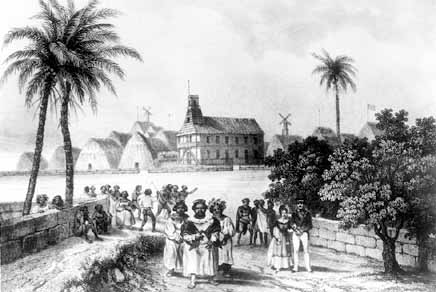 The undermining of Hawaiian culture accelerated in 1820, when the first of the Calvinistic Christian missionaries arrived from England and began to convert the Hawaiians from polytheism to the one True God, whose son was Jesus Christ. The Hawaiian chiefs resisted this new God for a time, but within a decade this new strict, moral Christian code was replacing the kapu system and the Hawaiian's sensual way of life. The Calvinists insisted that the Hawaiians wear more clothes, learn to read and write, work more and play less. Restrictions on play included surfing. People who knew Hawai'i before and after accused the missionaries of ruining much of what was unique and good about Hawai'i, and that included discouraging Hawaiians from surfing. |
| ||||||||||||||||||||||||||||||||
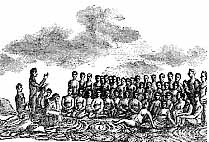 As early as 1838, a visitor to Hawai'i noted that: A change has taken place in certain customs… I allude to the variety of athletic exercises, such as swimming, with or without a surfboard, dancing, wrestling, throwing the javelin, etc. all of which games, being in opposition to the strict tents of Calvinism, have been suppressed… Can the missionaries be fairly charged with suppressing these games? I believe they deny having done so. But they write and publicly express their opinions, and state these sports to be expressly against the laws of God, and by a succession of reasoning, which may readily be traced, impress upon the minds of the chiefs and others, the idea that all who practice them, secure themselves the displeasure of offending heaven. Then the chiefs, for a spontaneous benevolence, at once interrupt customs so hazardous to their vassals. |
| ||||||||||||||||||||||||||||||||
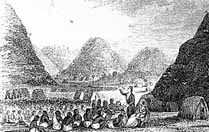 Harsh words, which drew a response from Hiram Bingham, one of the staunchest defenders of the missionary position: "The decline and discontinuation of the use of the surfboard, as civilization advances, may be accounted for by the increase in modesty, industry and religion, without supposing, as some have affected to believe, that missionaries caused oppressive enactments against it." (Houston and Finney, Surfing: A History of the Ancient Hawaiian Sport.) |
| ||||||||||||||||||||||||||||||||
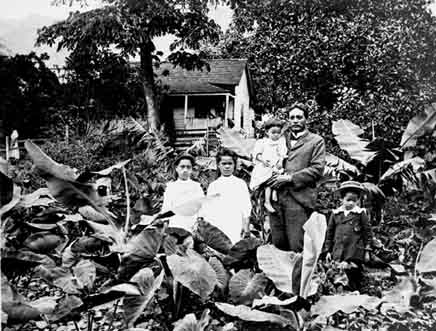 The "oppressive enactments" of the missionaries were those very things: modesty, industry and religion. The missionaries frowned upon or forbade wearing loin cloths, gambling and the close intermingling of men and women on land and sea. With this enforced modesty and morality applied to surfing, Hawaiians very quickly lost interest in the sport. To put it in a modern idiom, if you couldn't bet money or get naked or meet chicks, where was the fun? The only thing dying faster than Hawaiian culture were the Hawaiians themselves. Ravaged by diseases, alcohol and other poisons brought ashore by the flood of post-Cook haole, the Hawaiian population dwindled from somewhere between 400,000 and 800,000 natives at the time of Cook's arrival, to a mere 40,000 by 1896. Despite the imposed Calvinistic morality, surfing didn't disappear altogether from Hawai'i in the 1800s. While not practiced as widely and relentlessly as when Europeans first came, surfing continued throughout the islands. At times, even an adventurous visitor would catch a wave, sit on top of the world and then tell the world all about it. |
| ||||||||||||||||||||||||||||||||
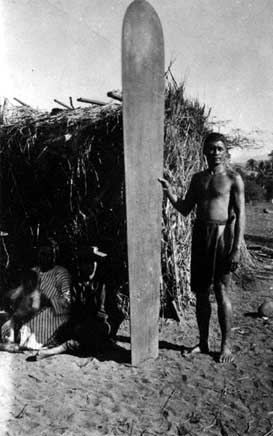 In 1851, the Reverend Henry T. Cheever observed surfing at Lahaina, Maui and wrote about it in his book, Life in the Hawaiian Islands, The Heart of the Pacific As it Was and Is. "It is highly amusing to a stranger to go out to the south part of this town, some day when the sea is rolling in heavily over the reef, and to observe there the evolutions and rapid career of a company of surf-players. [The sport of surfing] is so attractive and full of wild excitement to the Hawaiians, and withal so healthy, that I cannot but hope it will be many years before civilization shall look it out of countenance, or make it disreputable to indulge in this manly, though it be dangerous, pastime." Fifteen years later, Mark Twain sailed to the Hawaiian Islands and tried surfing, describing it in Chapter XXXII of his 1866 book Roughing It. "I tried surf-bathing once, subsequently, but made a failure of it. I got the board placed right and at the right moment, too; but missed the connection myself. The board struck the shore in three-quarters of a second, without any cargo, and I struck the bottom about the same time, with a couple of barrels of water in me." |
| ||||||||||||||||||||||||||||||||
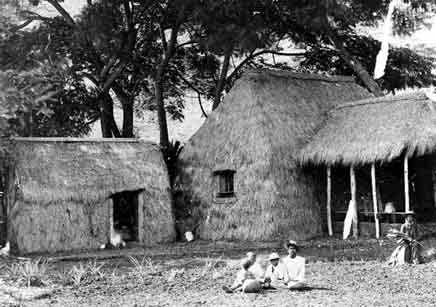 Surfing wasn't dead in the Hawaiian Islands in the late 1800s, but it was drowning, along with most Hawaiian customs and most Hawaiians. After 125 years of Hawaiian-European contact/ conquest, the haole had tried to exercise control over just about everything Hawaiian: their Gods, their culture, their magic, their land and their lives. Of the 40,000 Hawaiians that remained, a handful attempted to resist the 1893 illegal overthrow of the Hawaiian monarchy by a coalition of businessmen, plantation owners and missionaries, assisted by U.S. marines. The Hawaiians asserted their native rights to maintain Hawai'i as a sovereign nation under Hawaiian control. When Queen Lili'uokalani attempted to roll back haole control of the kingdom in 1893, the foreigners overthrew and imprisoned her. In 1898, the United States annexed Hawai'i as a territory.
|
| ||||||||||||||||||||||||||||||||
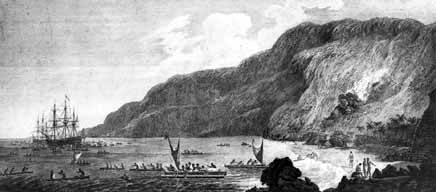


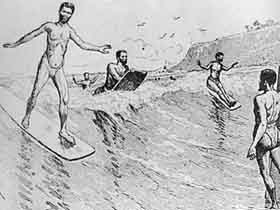 By 1779, riding waves lying down or standing on long, hardwood surfboards was an integral part of Hawaiian culture. Surfboard riding was as layered into the society, religion and myth of the islands as baseball is to the modern United States. Chiefs demonstrated their mastery by their skill in the surf, and commoners made themselves famous (and infamous) by the way they handled themselves in the ocean. Anthropologists can only guess at the origin and evolution of wave-riding and surfboard construction in Polynesian culture, since there's no certainty about the timeline and movements of the Polynesians. Around 2000 B.C., the migration of humans out of Asia and into the eastern Pacific began, and Polynesians established themselves within a large triangle, with Aotearoa (New Zealand) at the south point, Tonga and Samoa along the western boundary and Tahiti and the Marquesas to the east.
By 1779, riding waves lying down or standing on long, hardwood surfboards was an integral part of Hawaiian culture. Surfboard riding was as layered into the society, religion and myth of the islands as baseball is to the modern United States. Chiefs demonstrated their mastery by their skill in the surf, and commoners made themselves famous (and infamous) by the way they handled themselves in the ocean. Anthropologists can only guess at the origin and evolution of wave-riding and surfboard construction in Polynesian culture, since there's no certainty about the timeline and movements of the Polynesians. Around 2000 B.C., the migration of humans out of Asia and into the eastern Pacific began, and Polynesians established themselves within a large triangle, with Aotearoa (New Zealand) at the south point, Tonga and Samoa along the western boundary and Tahiti and the Marquesas to the east.